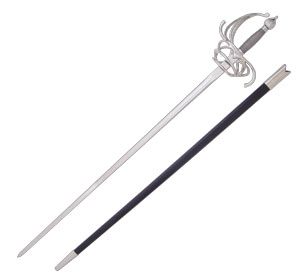Difference between revisions of "Steel rapier"
| Line 7: | Line 7: | ||
| time = 1 | | time = 1 | ||
| resources = | | resources = | ||
| − | | objects = [[steel rapier blade]]<br />[[ | + | | objects = [[steel rapier blade]]<br />[[hilt]] |
| tools = {{peen hammer}} | | tools = {{peen hammer}} | ||
| machines = {{anvil}} | | machines = {{anvil}} | ||
Latest revision as of 09:33, 24 November 2010
| Interwiki |
|---|
|
български • Deutsch • English • Español • Esperanto • Français • Italiano • Lietuvių • Lojban • Nederlands • Polska • Português • Русский • Suomi • Svenska • Türkçe • 中文 |
| |||||||||||||||||||||||||||||||||||
Description and uses
Real-life context
"A rapier is a relatively slender (blade 2.5 centimetres or less in width), sharply pointed sword with a blade at least 90 centimetres in length, often sporting an elaborate hilt and hand-guard. For most of its period of use, the rapier was double-edged, some later rapiers were single-edged (with a sharply triangular blade) or edgeless. A rapier is capable of both cutting and thrusting attacks, but the thrust is the main attack in all rapier fighting styles." - Wikipedia - Rapier
"The rapier appeared in the early renaissance and was a civilian weapon. Contrary to popular belief, by modern standards it was a heavy and cumbersome sword, capable of attacks only and ill-suited to defense, a role usually relegated to the left hand or an auxiliary implement held in it. In time it evolved into the small-sword, a shorter and much faster weapon, one equally capable of attack and defense." - Sword Forum International
